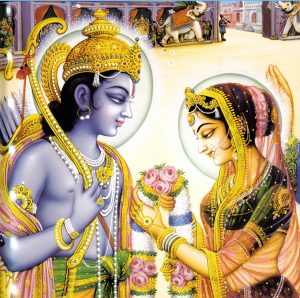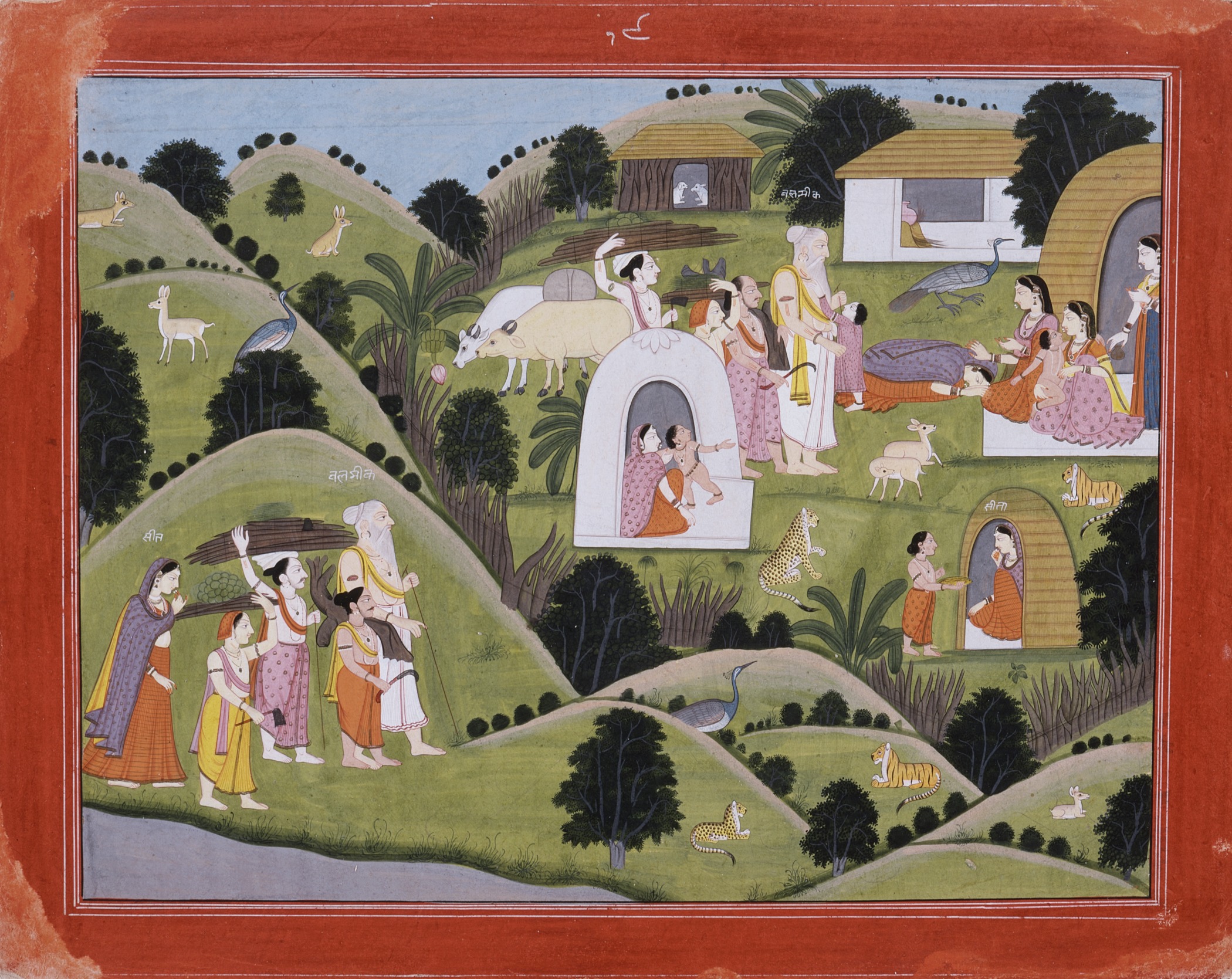No ancient story, not even Homer’s Iliad or Odyssey, has remained as popular through the course of time. The story of Ram appears as old as civilization and has a fresh appeal for every generation. – David Frawley (The Oracle of Rama)
Did Lord Ram love Sita as much as Sita loved Him? In the Ramayana, spanning over 24,000 verses, the descriptions of Ram’s lamentation after losing His wife are heart-wrenching. It’s obvious He was dedicated to Her as she was to Him.
Rishi Valmiki has devoted four chapters to describe Ram’s intense separation from his wife (Aranya Khanda-chapters 60-63). In the next section (Kishkindha Khanda- chapter 27) when Ram is at the Parsvana mountain, He is again despondent, and his younger brother Lakshman gives him hope.
Later in the Uttara Khanda Ram is forlorn at the prospect of losing His beloved Sita; He cries to Lakshman that He’d know no happiness without Her. Although it was a common tradition then for kings to have many wives, His father had more than three hundred, Ram chose to rule for the next ten thousand years without one. He suffered in separation.
Ironically, Ramayana reveals Ram as an emotional person who deeply loved his wife, a stark contrast to what is made of Him by certain Indologists.

Therefore the basic premise with Ram as a chauvinist, and Ramayana, a product of a culture that breeds on macho bigotry is wrong. Ram’s attitude was exemplary. He was tender hearted, and selfless. He gave up his own pleasures, to follow the path of righteousness.
Yet, a common challenge posed by the educated, yet confused Hindu is:
“Ram was selfish; he was more interested in his own reputation than to protect his chaste wife, Sita.”
The proof: He abandoned mother Sita because he heard a washer man, who disowned his wife for staying with another man one night, accuse: “I am not like the coward, infatuated Ram, who would accept a wife even after she stayed with another man.”
Thus, the argument: ‘Ramayana teaches values that are out dated and inhuman’.
However, if Ram was a coward why would He even fight a bloody war? And If he was selfish would He send Her away; would He not keep Her with Himself? To answer this we need to understand the principle of dharma as Duty.
The Dharma Conflict
Dharma is derived from the Sanskrit ‘Dhr’ which means ‘to sustain’, ‘carry’ or ‘hold’’. Each one of us is responsible to live in a way that helps human society sustain life, in harmony with cosmic laws. The universe is sustained by subtle laws, and when we confirm to righteous behaviour, say as parents we care for our child, we make our contribution to ensure this balance. That is called dharma.
The challenge however would be when two duties conflict and you could choose only one. Unlike the animals that act on instinct, humans are bestowed with the gift of choice.
For instance, your boss insists on working late hours, but your child repeatedly falls sick, and you need to give more attention to her. What’s the right thing to do?
Dharma is also relative; what is deceit in one situation could become truth in another. A man chased by assailants, knocks on your door. Would you give him shelter? If you do, and moments later, the muggers ask if you have seen a man they were chasing come over, would you speak the truth? Or would you rather mislead them so that an innocent life is saved?
Dharma is personal. Although we are guided by many – the wisdom books, family, and friends – it’s ultimately our conscience, the inner moral compass that directs our daily decisions.

Ram had a tough decision to make. His cabinet of ten trusted ministers confirmed that many citizens scorned him for his blind love for Sita. As a king, He was condoning apparent adultery by accepting Her. They denounced not Sita, but Ram. He knew a king’s currency to serve is the mandate of his citizens.
As a husband, what Lord Ram did could be unacceptable, but considering his other role as a king, He was in a dharma conflict. To declare His decision as faulty is very amateurish. Most of us naturally think and act within our limited views of life. We are not kings, and may have no idea of what it means to keep thousands of other people happy and in order. We may even find it strange when one choses to suffer to serve others. And that’s what Ram did. When Vibhishana offered Lord Ram the kingdom of Lanka, the Lord denied, saying, “Mother and motherland are greater than heaven”. To serve his country the best way he could, he sacrificed his love.
“But is Sita not a citizen? Should Ram not protect her?”
Did Ram Abandon Sita?
No!
While Ram was banished by Kaikeyi, He did not do the same with His wife. He cared for Her by sending Her to Rishi Valmiki’s ashram where saintly women attended to Her needs, and gave Her spiritual shelter. As she wept feeling pangs of separation from Her Lord, Ram too cried remembering His beloved Sita.
While Ram’s exile was a result of an evil ploy, Sita being sent to the ashram was Ram’s sincere attempt to balance His different dharmas.
Mother Sita’s Response
If Ram’s exile was a life of uncertainty, Sita’s stay in Valmiki’s ashram was a life of devotion; She accepted the decision with grace and maturity, knowing the intricacies of kingly dharma.
Additionally Sita was not a timid, emotionally abused woman who was forced to toe her husband’s line of thought. She was independently thoughtful, and assertive.
Indeed earlier, it was Her decision to accompany Lord Ram to the forest. When Lord Ram persuaded Her to stay back at Ayodhya, arguing that forest life is fraught with dangers, She admonished Ram. She wondered aloud if Her father had married Her off to a woman who was in the guise of a man! Ram, seeing Her determination, took Her along.
Now at the ashram, she accepted Her situation as the inevitable twists and turns of life, on which we have little control.
Sita Knew Her Dharma
After killing Ravana, Ram cried as he announced to Sita that he had nothing to do with Her. She was furious, and decided to enter fire to prove her chastity. The incident was orchestrated by the Lord to present to the world Sita’s purity. This is confirmed in Koorma Purana: Sita was under the care of God of Fire, and through the fire test, she was returned to Ram.
Sita very well knew her duties, and she chose to follow her dharma. If Ram’s decision to send her to the Ashram was a wrong one, she would have refused to honour it, just as years ago she refused to stay back at the palace when he told her to.

In another instance, when Hanuman told Sita to hop on her back so that he could take Her safely to Ram, She again revealed Her clear thinking and decisive action. There was little time to lose, and Hanuman was offering Her a chance to escape from Ravana’s Lanka. Yet she refused, insisting that it was the duty of Her husband to come and fight Ravana, and take Her honourably from Lanka.
Three Levels to See the Pastime
Ram sending Sita away could be seen at three levels.
- The challenge of balance
We have various duties, and it’s not easy to perform all of them. If we could perform even fifty per cent of our expected dharma, we’d consider ourselves successful. Ram, on this occasion, reveals our delicate predicament in this world. One could imagine that if Lord Ram, despite his best intentions, is not free of censure, how much more difficult it is for us to perform our dharma?
If one phoo-phoo’s the dharma conflict, it only means he or she hasn’t lived long enough; life always throws up dilemmas, and you have to simply live long enough to experience them.
- A leadership lesson
Lord Ram’s incarnation had the specific purpose of setting the example of an ideal leader.
In different incarnations, the Lord fulfils a specific purpose. As Parashuram, He annihilated the warrior class twenty one times. As Buddha, He taught non-violence. One can’t accuse Parashuram of not doing what Buddha did. Similarly as Krishna, the Lord cared for all his sixteen thousand wives; he even lied and cheated to protect His devotees. He was the incarnation of a lover, who broke all rules to reciprocate with his beloved. But when He came as a sannyasi, Shri Chaitanya Mahaprabhu, he had no dealings with women. Likewise as Lord Ram, his purpose was to teach us how a true leader is willing to give up what he loves the most, for a larger good.
- Love in seperation
The Lord has his own agenda and internal reason for his incarnation.
Lord Ram relished the mellow of vipralambha bhava or love for his devotees in separation.
When two lovers meet, there is happiness. But when they are separated, the intensity of emotions churned in the heart is richer. The pain of not being with the beloved strengthens the lovers hankering.
This principle applies even in our relationship with God. The desperation in separation is a greater devotional ecstasy than physically being in the Lord’s association.
Lord Ram’s Humanness
Lord Ram and His devotees experienced this love many times. When Ram was banished to the forest, His father Dasharath and the citizens of Ayodhya felt deep pain of separation. Bharat and Ram too felt this reciprocal love. An old and simple woman named Shabari who waited for years to see Ram, exemplifies serving the Lord in separation and hope.
While Ramayana is filled with pastimes exemplifying this mood, Sita-Ram’s separation is the pinnacle of this emotion. The time they spent in separation churns the reader’s heart with love and tenderness. Interestingly, in Lord Krishna’s pastimes, devotees are seen crying in separation but we hardly find Krishna crying in separation from his devotees. However in Lord Ram’s pastimes, the Lord’s lamentation and his transcendental emotional outbursts are there for all to see. This helps one appreciate Lord Ram’s humanness; and feel the love He feels for us.
The Paradox of Ramayana
The most beautiful paradox of the Ramayana story is that there is pain and suffering, yet it’s deeply nourishing and irresistible for the reader. Usually when we read a tragedy, there is meaningless pain. However the suffering in Ramayana is like the hot chutney – sauce of Indian cuisine. The chillies and spice burns the tongue, yet it tantalizes one’s senses; one wishes to have more of it. Bhaktivedant Swami gave the example of hot sugar cane juice. The temperature makes one uncomfortable to drink it, yet the sweetness entices one to drink more of it.
Ramayana begins with Rishi Valmiki, the author, seeing the painful separation of a female Crauncha bird (Sarus Crane) that witnesses her partner being shot by a hunter. She wails piteously, and Valmiki feeling compassion for the suffering bird, pronounces a curse on the hunter. Even as he succumbs to anger, Valmiki is surprised that his outburst came out in perfect poetic meter. As he wonders about this incident, the leader of the universe, Lord Brahma appears before him and explains how his cursing is a propitious sign; it’s an indication that he should write the Ramayana, extolling the glorious love of Lord Ram and his devotees for each other. The cursing of the hunter becomes the first verse of this immortal classic, and sets the mood of transcendental sorrow and love in separation, for the remaining part of the book.
The Ramayana ends with Sita going back to her abode, under the earth, and thus intensifying Lord Ram’s separation from her.


